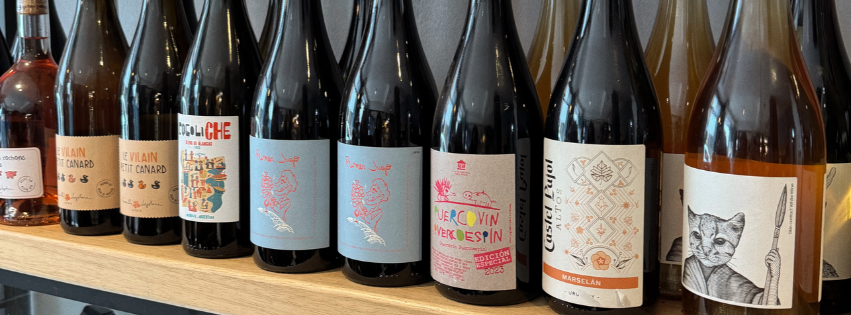
How To Read Wine Labels (Without the Jargon)
|
|
Time to read 4 min
|
|
Time to read 4 min
Wine labels can be beautiful, mysterious… and sometimes downright confusing. From swirling fonts to unfamiliar regions, it’s not always clear what’s actually in the bottle.
But understanding how to read wine labels doesn’t have to be intimidating. In fact, once you know what to look for, you can tell a lot about a wine before you even pop the cork.
Whether you’re browsing shelves in-store or scrolling online, here’s our no-fuss guide to decoding wine labels — so you can shop with confidence.
Because there’s no one way to do it. Depending on where the wine is made, you might see the name of the grape, the place it’s from, or sometimes both… or neither.
Labels from France and Italy often highlight the region (like Bordeaux or Chianti), while New World wines – think Australia, South Africa, Chile – usually lead with the grape (like Shiraz or Sauvignon Blanc).
To make it easier, let’s break down the key basics of how to read wine labels step by step.
Choosing a bottle can feel overwhelming when you’re faced with a wall of unfamiliar names, vintages and regions. Learning how to read wine labels makes the whole process easier — giving you the confidence to pick a bottle you’ll actually enjoy. From understanding grape varieties to spotting quality markers, here’s the key info to look out for when you’re scanning the shelves.
1. The Producer or Brand Name
Usually at the top of the label. This is the winery, estate, or company that made the wine. Sometimes it’s a big, recognisable brand, but often you’ll see unfamiliar names — especially with European or small producers. Don’t let that put you off; the name is simply telling you who made it. At Crushed & Cured, we work mostly with small producers – the kind who care more about what’s in the bottle than flashy branding.
2. The Grape (Varietal)
If it says “Chardonnay” or “Pinot Noir,” that’s the grape used. This helps you get a rough idea of taste. But in many European wines, the grape isn’t listed — you’ll just see the region instead. For example, a bottle labelled “Sancerre” almost always means Sauvignon Blanc, while “Barolo” means Nebbiolo. If you don’t see the grape, check the region — it’s often the clue.
3. The Region
The place the wine comes from will always be on the label. Sometimes it’s as broad as “California” or “Spain,” sometimes as specific as “Margaux” or “Chianti Classico.” Regions are important because they tell you the style — a Malbec from Mendoza will taste different from one grown in France.
Where the wine comes from can tell you a lot about the style. For example:
Chablis = Crisp, mineral-driven Chardonnay from northern France
Marlborough = Zesty Sauvignon Blanc from New Zealand
Barossa Valley = Rich, bold Shiraz from Australia
We love championing bottles from both classic and off-the-beaten-track regions – and knowing where it’s from is a great way to start exploring.
4. The Vintage (Year)
This is the year the grapes were harvested. It gives you a sense of the wine’s age – and sometimes the growing conditions too (some years are considered “better” than others, depending on the weather).
5. Alcohol Percentage (ABV)
Printed in small type at the bottom. This isn’t just about how strong the wine is — it also hints at style. Lower numbers (11–12%) often mean lighter, fresher wines. Higher numbers (14%+) usually mean richer, fuller wines.
Appellation – A protected wine region, usually in France or Italy. These appelations will only permit the use of certain grape varieties for the wine to classify for the appellation status. For example, AOC, DOC, or IGP.A (see below) perfect example of this is Chardonnay, Aligoté and Pinot Noir are the only grapes that can be grown in Burgundy.
Estate Bottled / Mis en Bouteille au Château – Means the wine was made and bottled at the winery itself.
Quality Classifications (DOC, DOCG, AOC, IGP, etc.)
These little acronyms can look confusing, but they’re actually there to reassure you about quality and origin.
AOC (Appellation d’Origine Contrôlée) – France’s guarantee that the wine was made in a specific region, with strict rules on grapes and style.
DOC (Denominazione di Origine Controllata) – Italy’s version, protecting traditional regions. You might also see DOCG (the “G” stands for Garantita) which is a step up, marking even stricter standards and usually higher quality.
IGP / IGT (Indication Géographique Protégée / Indicazione Geografica Tipica) – looser rules than DOC or AOC, often used for more modern or experimental wines.
These aren’t about “good vs bad” — just different levels of tradition and regulation. A DOC Chianti will be classic, while an IGT Toscana might be a winemaker’s creative twist.
Flip the bottle over and you’ll often find extra information to guide your choice. Back labels can include:
Flavour notes (“fresh citrus and peach” or “ripe dark berry fruit”)
Food pairing suggestions to help match your meal
Serving temperature tips for getting the best taste
Importer details (useful for knowing who has selected the wine for your market, and often a good sign of quality curation)
More and more labels now mention how the wine was made – whether it’s organic, biodynamic, or made with minimal intervention. These are all things we look for when choosing bottles for our shop. If it’s not on the front, check the back label for the details.
If you’re looking to understand labels better, we’ve put together a few bottles that are perfect for label-spotting (and drinking):
Reading wine labels doesn’t need to be complicated – it’s just about knowing what to look for. Whether you’re after something classic or a new hidden gem, that label holds clues to help guide you.
And if you ever get stuck? Just ask. We read wine labels for a living.
